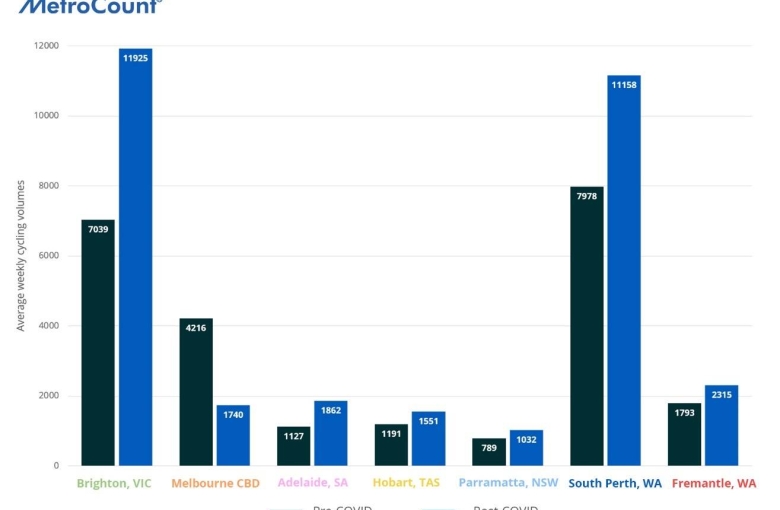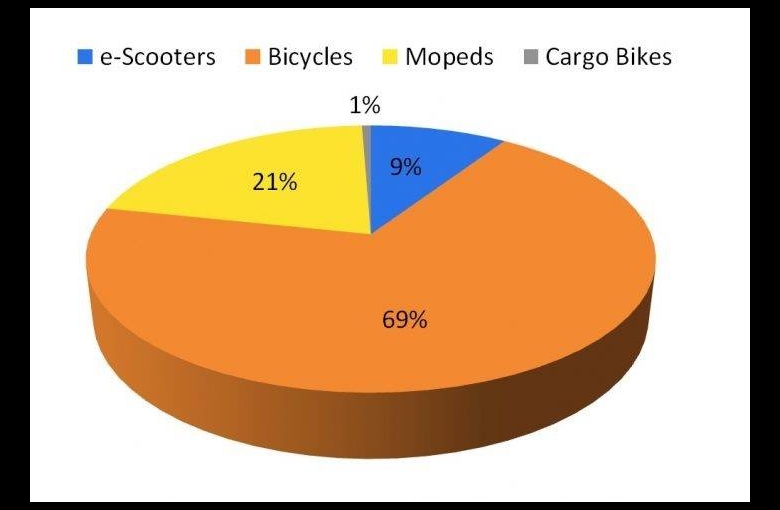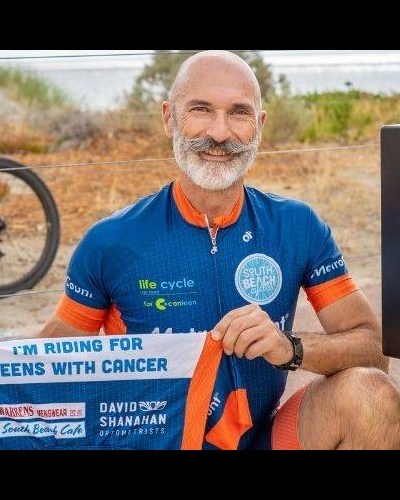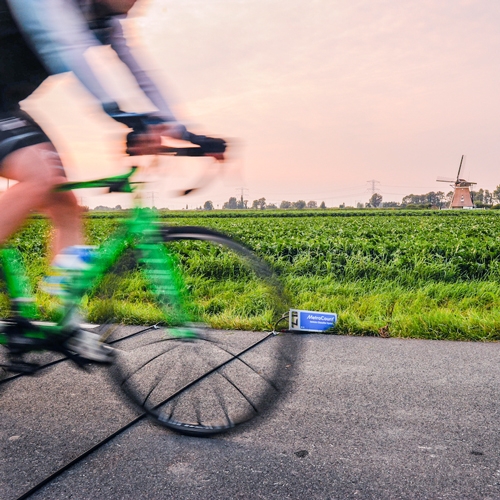Avec la croissance de la population et l’urbanisation continue, les défis en matière de mobilité sont nombreux. La durabilité, la sécurité et l’impact sociétal font partie de nos préoccupations quotidiennes. Nous devons accélérer la transition vers la mobilité pour suivre l’évolution rapide de la dynamique mondiale, ce qui nécessite des approches inventives et de meilleures solutions. Dans cette série, nous partageons des cas inspirants et innovants du monde entier. Maurice Berger, responsable du développement commercial de MetroCount, souhaite accroître son impact social. Comment accélère-t-il la transition vers la mobilité ?
MetroCount est une société Australienne réputée depuis plus de 30 ans pour la fabrication de compteurs de trafic extrêmement robustes et fiables. Aujourd’hui, les systèmes MetroCount sont utilisés dans 120 pays pour rendre les routes, les pistes cyclables et les voies partagées plus sûrs et plus efficaces. MetroCount est ravi d’être à l’avant-garde de la surveillance des déplacements actifs aux côtés du trafic motorisé et de la création de solutions innovantes pour aider les gouvernements à tirer le meilleur parti des données sur le trafic. Un tout nouveau logiciel d’analyse automatisé basé sur des cartes contribue à faire exactement cela.
“J’ai une formation de chimiste industriel et j’ai commencé ma carrière en portant une blouse blanche. « J’ai réalisé que je préférais rester avec les clients et écouter leurs besoins. Après avoir travaillé dans la vente, j’ai commencé comme responsable du développement commercial chez MetroCount il y a 18 ans. Je travaille principalement sur la gestion de projets pour des produits complexes en Turquie et en Chine et je donne des formations en ligne sur nos produits.”
“Après la pandémie, la circulation n’était pas normale et les clients ont d’abord estimé qu’il était inutile de la surveiller. ”
“La pandémie nous a obligés à repenser une grande partie de ce que nous faisons. Au début, nous avons connu une baisse des ventes, car le trafic n’était pas normal et les clients ont d’abord estimé qu’il était inutile de le surveiller. C’était un argument intéressant. Nous avons donc dû poursuivre cette discussion. Serait-il judicieux de ne pas surveiller pendant un certain temps, puis de recommencer lorsque la situation redeviendra normale ? Il a fallu un certain temps à la communauté pour comprendre qu’il ne sert à rien d’attendre. Nous ne saurions jamais quelle serait la nouvelle norme et quand. Vous ne sauriez pas ce qui a changé. Ce qu’il était important de savoir, par exemple, c’est qu’à certains endroits, le nombre d’accidents a augmenté. Avec moins de véhicules sur la route, les gens ont choisi de conduire plus vite. Il était donc important de mesurer la vitesse afin de gérer la sécurité routière.”
“Au cours des douze derniers mois, nous avons vu le nombre de cyclistes tripler dans certaines régions. En Australie, on a constaté une augmentation soutenue de plus de 50 % du nombre de cyclistes et le nombre de cyclistes a doublé le week-end. Même pendant les mois d’hiver, les chiffres étaient bien plus élevés que les années précédentes.”
“Notre attention s’est donc portée sur la surveillance des pistes cyclables éphémères. Nous avons investi davantage dans la surveillance des piétons et des cyclistes et pouvons désormais différencier les vélos des trottinettes et des piétons. Nous avons également créé un logiciel en ligne permettant à chacun d’analyser rapidement et facilement les données et de visualiser les statistiques sur une carte interactive. Cela signifie que nous pouvons fournir des données en tant que service aux clients qui n’ont pas le temps ou l’expertise pour la collecte de données. Nous téléchargeons toutes les données des pistes cyclables sur la plateforme en ligne et vous pouvez immédiatement voir les vitesses, la direction, le volume et le type de mode de mobilité. De cette façon, nous pouvons tous accroître la transition de la mobilité.”
“Le suivi de la répartition modale n’est pas facile à réaliser, que ce soit en zone urbaine ou rurale. Il est difficile de déterminer l’effet d’une augmentation du nombre de cyclistes sur le volume de véhicules motorisés. Cela nécessite une collecte de données à long terme, ce qui est désormais possible grâce à nos systèmes intégrés en permanence.”

“Par exemple, en 2019, nous avons analysé la répartition modale sur une piste cyclable parisienne. L'analyse des données permet d'identifier clairement les tendances quotidiennes, hebdomadaires et mensuelles :
- la plupart des usagers de la piste utilisent des vélos classiques (69,1 %), suivis des cyclomoteurs (21,1 %), des trottinettes électriques (9,3 %) et des vélos cargo (0,6 %) ;
- une forte tendance à l'augmentation des vitesses pendant la nuit ;
- une préférence pour les déplacements en direction du sud (le trafic en direction du sud est plus de deux fois supérieur à celui en direction du nord) ;
- la majorité des usagers sont probablement des banlieusards plutôt que des cyclistes de loisir."

“Différencier les modes de déplacement actifs sur une piste cyclable parisienne”
“En nous concentrant sur la surveillance des transports actifs, notre impact social est devenu beaucoup plus important. Nous avons un problème de santé de plus en plus important lié à l’inactivité : le diabète et l’obésité ont augmenté depuis les années 70 et 80. Il fallait que quelque chose de grand change et je pense que c’est ce qui se passe en ce moment. C’est tellement important ! ”
“Heureusement, beaucoup de gens ont déjà remarqué qu’ils n’ont plus besoin de se déplacer en voiture. Je ne dis pas qu’il faut se débarrasser de sa voiture, mais les trottinettes et les vélos électriques deviendront plus populaires car ils permettent aux gens de se déplacer plus loin qu’avec un vélo normal. Plus les gens s’en rendront compte, plus ils commenceront à utiliser la mobilité électrique. De plus, de plus en plus de gouvernements investissent massivement dans les infrastructures de déplacement actif pour encourager davantage de personnes à faire du vélo et à marcher.”
“L’autre avantage de la mobilité active est l’engagement des communautés. Plus les gens font du vélo ou marchent, plus nous sommes proches les uns des autres. Lorsque nous sommes assis dans un train, nous avons tous la tête baissée et les yeux rivés sur notre téléphone. Le vélo et la marche offrent un moyen d’accroître les contacts sociaux avec les gens qui vous entourent.”
“Nous devons changer notre vision des rues pour les orienter davantage vers les gens et moins vers la voiture”
“Je pense que la mobilité du futur ne sera pas tant une histoire de science-fiction et de planches volantes (hoverboards). L’avenir sera davantage une question d’infrastructures de transport actif. Plus de pistes cyclables séparées, de stationnement pour vélos et de rues locales avec des limitations de vitesse plus basses. Devrions-nous réduire la vitesse à 30 km/h ou même moins dans les rues à faible trafic ? Si c’est le cas, on ne peut pas se contenter de mettre un panneau sur un poteau et de s’attendre à un changement. Il faut également modifier l’infrastructure routière, comme les boucles, les bosses, les impasses, etc. Nous devons changer notre vision des rues pour qu’elles soient plus axées sur les personnes et moins centrées sur la voiture. Nous avons besoin de plus d’arbres, d’espaces verts et même de reconsidérer la façon dont nous construisons nos maisons. Ne construisons plus une maison avec un garage à l’avant qui nous coupe de nos voisins. Il reste encore beaucoup à faire et tout cela est lié à la mobilité.”
“Le plus grand défi pour la mobilité du futur consiste à encourager les organisations gouvernementales à opérer des changements plus importants. Nous devons travailler sur le long terme. Les gouvernements ont tendance à arrêter les projets trop tôt pour qu’ils montrent des résultats. Nous voyons de plus en plus de clients repousser les limites de ce que nous pouvons faire pour eux. L’un des défis consiste à s’en tenir à ce que nous connaissons et à le faire correctement plutôt que d’essayer de nouvelles choses. Dans notre domaine, l’IA et la vidéo se développent de plus en plus. Nous devons nous demander quelle est la place de MetroCount. ”
“Je trouve que c’est un défi personnel d’avoir un impact social ! Participer à des groupes consultatifs et de défense est très important pour écouter ce que la communauté veut avant que le gouvernement nous demande de le mettre en œuvre. Nous voulons participer à la discussion communautaire dès le début. Créer davantage de journées sans voiture est une excellente occasion d’engager les communautés et d’améliorer la santé, mais nous avons besoin de plus d’idées nouvelles. Je ressens beaucoup d’énergie lorsque de nouvelles personnes ont de nouvelles idées. Il ne faut jamais rester coincé dans le courant ou dans ce qui est familier simplement parce que l’on pense que cela fonctionne. C’est à nous de faire en sorte que les actions se concrétisent et de veiller à ce que cette transition se poursuive. Il est important de s’impliquer, de s’exprimer et de continuer.”
L'article a été initialement publié sur Intertraffic, le mercredi 18 août 2021. Lisez l'article original ici.
Got a great MetroCount story? Share it with us and let the world know the great work you're doing in your community.

